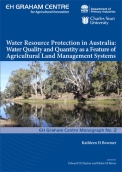Part 1: Policy and planning priorities in water resource protection
Three stakeholder classes are used as a basis for ranking the significance of water quality and quantity issues in Australia. Rankings, assessed as priorities for management intervention and investment, are derived from views of several leading natural resource and water utility managers, supplemented by a review of the literature. The stakeholder groups are (1) rural and irrigation (this includes riparian rights to access water known in Australia as ‘stock and domestic supply’); (2) urban water used for drinking and industry including power generation; and (3) aquatic ecology and ecosystem resilience (this includes water for aesthetic, spiritual, recreational and cultural purposes). Water characteristics used for the significance assessments are: salinity; acidity; nitrogen and phosphorus; carbon; turbidity; micro-pollutants; pathogenic organisms; volumetric water availability and hydrological flow patterns.
Trends over the last decade show a reduction in concern for salinity, reflecting the effects of a drying climate in lowering groundwater levels; while investment in treatment technology has reduced the impact of eutrophication. Increased priority is allocated to micro-pollutants and pathogens that are associated with intensive re-use of water for drinking and uncertainty about impacts on human health. In the latter category, reduction of pesticide use is countered by increased risks from water recycling and poorly understood impacts of new pharmaceutical and industrial pollutants.
Part 2: Management methods
The off-farm downstream benefits and costs of stubble farming systems are reviewed and compared with alternative management options for protection of water quality and quantity. The management options are assessed under categories of (1) prevention (including watershed protection methods); (2) interception (such as the use of salinity evaporation ponds, protection of the riparian zone and use of wetlands for effluent treatment and stormwater interception; and (3) treatment (such as disinfection and filtration). The many benefits of stubble farming systems include reduction in turbidity and associated pollutants through effects in reducing hillslope erosion, and reduction in concentration of salt in run-off through water retention in the landscape. The effects of stubble farming on the water cycle and on the groundwater profile at local and catchment scale is a knowledge gap.
Part 3: Links between land use and river health
Stubble farming has increased in Australia over several decades with claims of improved productivity, landscape stability and environmental benefit, yet recent audits show a dramatic and general decline in river health. Explanations for this apparent anomaly are explored. The link between stubble farming and downstream water quality and quantity is confused by effects of climate change and variability, other agricultural and riparian land-use changes, effects of introduced species, lag times and effects of scale. Additionally, cost-benefit analysis is complicated by changing perceptions of the value attributed to the aquatic environment.
Assessing the value of ecosystem services provided by stubble farming could be aided by the use of environmental indicators (such as vegetation cover), modelling, ecological risk assessment, and farmer-based sustainability initiatives.
Integrated catchment management is a particular responsibility of regional natural resource management groups and catchment management authorities in Australia. The strengthening of local, regional and catchment-scale approaches is advocated. This includes the re-integration of land management and governance with water management and planning. It is encouraging that some farmers are themselves developing systems to optimise trade-offs between on-farm activities and ecosystem service benefits; these initiatives are commended.
Prognosis
Land management systems in general, and stubble farming systems in particular, are important drivers of water resource condition but the integration of land and water management appears to have been downplayed and under-funded in recent years. Links between land use and downstream water quality and ecosystem resilience are difficult to quantify because of the interaction of many confounding factors. Also substantial past investment in water treatment technology has enabled urban Australians to access safe water for drinking and industry, to some extent removing the pressures for greater investment in watershed protection. It is timely to revisit the catchment-based approach to landscape sustainability and resilience in Australia. In this context the provision of ecosystem services by stubble farming systems needs to be recognised, quantified and valued. Overall the ecosystem benefits reviewed here provide a rationale for increasing rather than reducing stubble-farming practices, and in investment in research to develop mechanical methods for stubble management.

